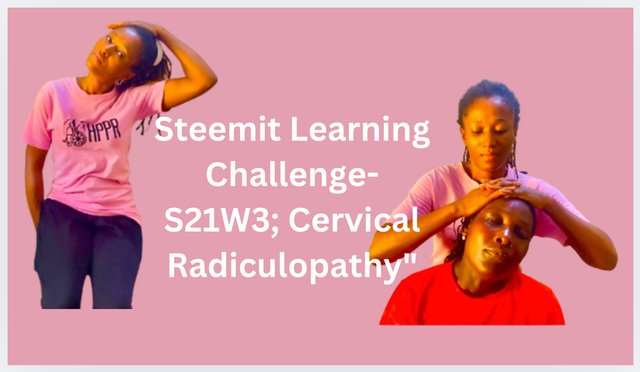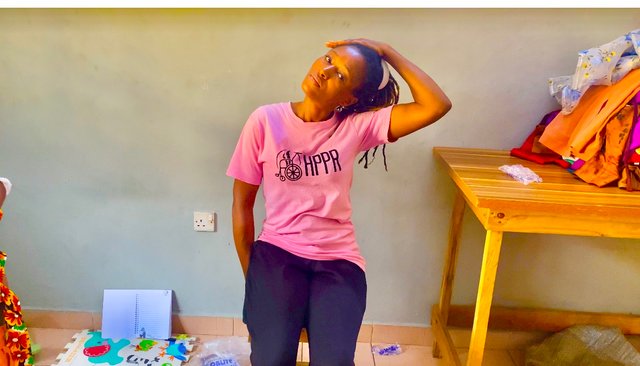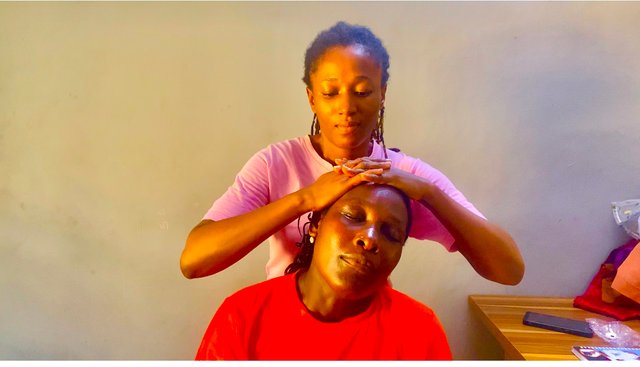Greetings and welcome to my blog. Am glad to be a part of this exciting class. Here’s my class task.
 |
|---|
What's Cervical Radiculopathy? Write in your own words after getting knowledge from the lesson post. |
|---|
Cervical radiculopathy is also called pinched nerve. it’s a condition that results in pain, numbness or weakness when there is a compression of any of the nerves in the root or starting point of the neck. Sometimes this numbness or weakness may extend to our arms.
In other words, When the nerve roots of the cervical becomes inflamed or compressed, it leads to a neurological dysfunction called cervical radiculopathy which is usually accompanied by visible pain and numbness.
The word cervical is gotten from the root word in Latin “cervix”. Cervix means neck. For a clearer understanding, you should know that in cases of cervical radiculopathy, the problem is not in the cervix but in the neck.
Our spinal cord is like the main road that connects all the nerves in our body to our Brain while the nerve root is the inceptive nerve proceeding from our spinal cord to every other part of our body. There are different nerve roots along our spine that stretched to various parts of our body. When one of these nerve roots is pinched it affects nerve that are connected to it and that’s what’s causes the pain in the neck that also goes down to the arm
Who can be affected by cervical radiculopathy?
Cervical radiculopathy affect anyone but it’s very common in adults. Out of ten thousand persons, it can affect about eighty five persons. The C6 nerve root is said to be affected in over a quarter of the cases of cervical radiculopathy while the C7 nerve root is affected in over half of the cases.
Symptoms and Causes of cervical radiculopathy

The nerves that connect to our necks stretches to other parts of our body such as our arms, shoulders, upper back and our chest. Because of this, the symptoms that emanates from cervical radiculopathy can go down to any or more parts of these body depending on the root nerve that was affected. Cervical radiculopathy in most cases usually affects only one side of our body for example the left arm. It won’t affect both arms. The nerves that connect to your cervical spine (neck) extend out to other body parts:
The symptoms that arise due to cervixal radiculopathy incudes:
- Numbness
- Muscle weakness
- Pain
- Weakness of the reflexes
- Needles and pins feeling or a tingling sensation.
The individual may feel one or a combination of the pains listed above. This pain is felt when the neck is strained, moved in a certain way or extended.
Causes of cervical radiculopathy
Cervical spondylosis: This is a degenerative change that occurs in the spine when someone ages. The wear and tear that happens in the neck with age causes stiffness of the neck and pains. Sometimes this can be called osteoarthritis of the neck
Herniated disk: This is when a disk in the neck bulges. As one get older or get injured, there can be a weakening or cracking of the outer layer of the disc vertebrae leading to the pushing out of the inner jelly through the crack. When this materials that leaked from the disk presses on the nerves of the spine, it results to cervical radiculopathy.
Factors that can lead to herniated discs includes:
- Lack of excercise
- Aging
- Poor posture
- Injury on the neck
- Incorrect twisting or lifting of the neck leading to additional Stress on the neck
This type of cervical radiculopathy is common in people who are up to fifty years and above.
How would you diagnose a Cervical Radiculopathy? Any clinical investigation or assessment tests? |
|---|
Diagnosis and Tests

When the doctor is visited by a patient with pinched neck, the healthcare provider would enquire from the patient about the following:
- Medical history
- History of accidents or injuries
- General health and
- Symptoms.
They will examine the neck, arms, shoulder and hands to check if there are any changes in the patient’s reflexes and find out the various sensation he is feeling. Cervical radiculopathy is unilateral (affects only one side of the body) hence the doctor would compare the sensations the patient is feeling on one side of the body to the other side.
He would ask the patient to do some neck and arm movements in order to relieve or recreate the symptoms. Many other conditions can cause pain such as neuropathy. Therefore the patient would be asked to undergo some imaging tests so that the diagnosis can be confirmed.
Tests to diagnose cervical radiculopathy
Apart from the physical examinations, these tests are used to diagnose cervical radiculopathy.
MRI (Magnetic Resonance imaging): The MRI scan enables the doctor to see the abnormalities in the soft tissues, the compressed nerves and also the herniated discs.
Electromyography (EMG): This test can help to dictate if the nerve is working well. An EMG test checks for muscles response or electrical activity reaction of a nerve’s activation of the muscle.
Spine X-rays: Cervical spine X-Rays is one of the common ways to produce imaging tests that checks for neck pain and pain in the upper part of the body. Issues such as foranimal or narrowing of disc space can be revealed from different angles and views.
CT scan (Computed tomography): This is used to diagnose traumatic injuries that resulted to cervical radiculopathy through the pictures of the inside of the body produced by the machine
Clinical investigation or assessment tests
The doctor would carry out some assessment test to confirm the diagnosis and the two basic assessments tests are:
- Spurling test: Spurling’s test is a test with a low sensitivity of about 50% and specificity of about 85% in diagonising CR hence it’s had moderate clinical value. It’s designed to provoke the symptoms which are normally neck pain with radiating pain down the arm.
It’s done with the patient’s neck in extension with the lateral bending to the affected side and extra compression. It is important to elicit distal pain distribution to be able to distinguish between patients with CR and spondylosis.
This test is more effective than others in deciphering between the two. It’s advisable to do neck extension and lateral bending first. If the symptoms are not reproduced, then add the extra compression.
- Cervical distraction test: This is to check if the symptoms the Patient is feeling is caused by CR. To perform this test, let the patient lie in a supine position.
Place each hands over the patients mastoid process while standing at the head of the bed. Flex the patient’s neck forward pulling the head towards you. Apply a distraction force at the hinder part of the head. It can also be performed sitting.
Cervical distraction test video; YouTube short
Treatment and management of cervical radiculopathy
Most cases of cervical radiculopathy (about 85%) gets better within 8 -12 weeks but if there’s persistence of symptoms, some treatment options can be embraced. The treatment option would be in accordance to how to patient’s situation is.
Some treatment option are:
- Medication
- Immobilization.
- Physical therapy.
- Use of cervical steroid injections
- Lastly surgery may be carried out in severe cases.
Most doctors would always start treatment with therapies that are not surgical for treatment of cervical radiculopathy which always works for about 90% of patients. If these therapies didn’t work. Then surgery is recommended.
Cervical radiculopathy can be managed shortly through wearing of neck braces so as to reduce the irritation of the nerve root and movement of the neck. The neck braces should not be worn at a stretch for more than two weeks so as to avoid the atrophy of the muscles of the neck.
Some medication that helps to relieve C.R is;
Oral corticosteroids: These are pain relievers taken through the mouth that reduces the swelling on all sides of the pinched nerve. This requires prescription.
NSAIDS also known as Nonsteroidal anti-inflammatory drugs: Examples are ibuprofen, naproxen, and aspirin which provides anti inflammatory effects and relieves pain. They attack the inflammation at the root nerves that has been affected. These can be taken without prescription.
Try to practice at least 3 exercises that you have learned from the lesson. Share images, gifs or videos while practising. |
|---|
Upper trapezius stretch
Take the arm of the side you want to stretch, push it downwards or sit on it to hold the shoulder down. Take the other hand on the other side and pull your neck towards your shoulder, holding the stretch down for a while and repeat about 5times.
Isometric neck retraction
Place both hands behind your head, attempt to pull your head backwards while taking your chi in slightly. Resist the movement with your hands. Keep your hands steady, you will feel a gentle contraction at the muscles of the back of the neck.
Isometric neck extension
This is performed by looking at the ceiling but you will place your hand at the back of your head and push into your hands. This helps to enhance neck extension as the range of motion is restricted and the pain can make neck extension difficult.
Share your review after performing these exercises either on yourself, healthy individual or patient. |
|---|
On performing the exercises, I felt the tension and pressure of the different exchanges on the muscles of my neck and arm. I didn’t feel any pains though but my neck muscles felt freer and better having excercised them. I’ve not done neck excercise in a very long while and having the opportunity to do them because of the lecture was great.
Thank you @ashkhan for this amazing class. I ask @ruthjoe, @wringo and @lirvic to join the challenge.
Upvoted! Thank you for supporting witness @jswit.
Downvoting a post can decrease pending rewards and make it less visible. Common reasons:
Submit
Thank you for understanding the lesson and sharing your assignment; I hope that you will enjoy this week's lesson and try to implement it in your life if you see any such case.
Observations
Task 1 (2.9/3)
You have shared a great knowledge about cervical radiculopathy, and it's causes, symptoms, treatment, also add the vertebrae involve in cervical radiculopathy & it's second name too. You share all the details but you can also add the age mostly commonly suffered with cervical radiculopathy. I appreciate your effort.
Task 2 (2.8/3)
In the second question, you tell us about how you have to assess a patient by doing the physical examination, history taking, investigations of patients and specialized tests. That's good you perform the special tests on someone else to demonstrate in a better way. You have share good knowledge but the best test for nerve examination is NCS nerve conduction study to assess. Great.
Task 3 (3/4)
You try the isometric cervical extension, retraction and upper trapezoius stretch. But while performing Isometric exercises you have to apply resistance & apply that much force that didn't allow head movement. You were moving your head easily and apply almost no resistance. But you apply the trapezoius stretch in correct way. Remember always apply heating pad to relax your muscles before performing these exercises. I appreciate your efforts.
Overall you made a great attempt to answer all the questions except question 3. I appreciate your efforts. But next time try to avoid the above written suggestions. Keep learning and try to implement your knowledge to the people suffering from any cervical radiculopathy. Thank you.
Downvoting a post can decrease pending rewards and make it less visible. Common reasons:
Submit